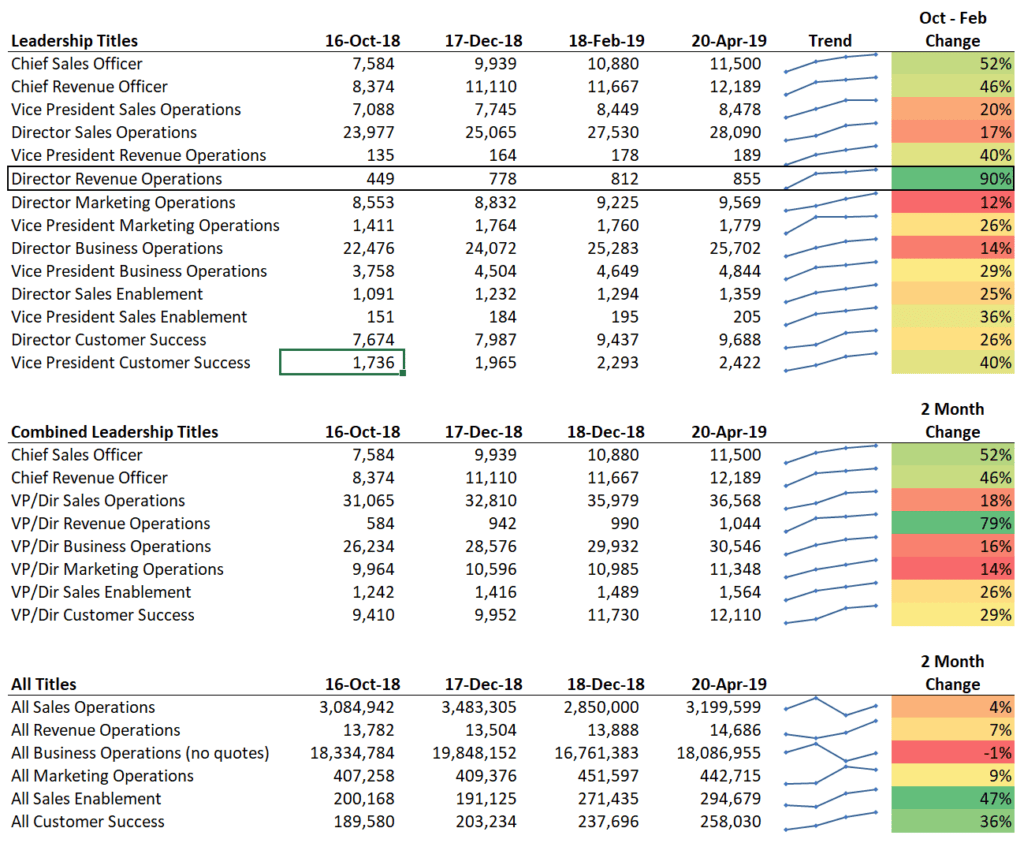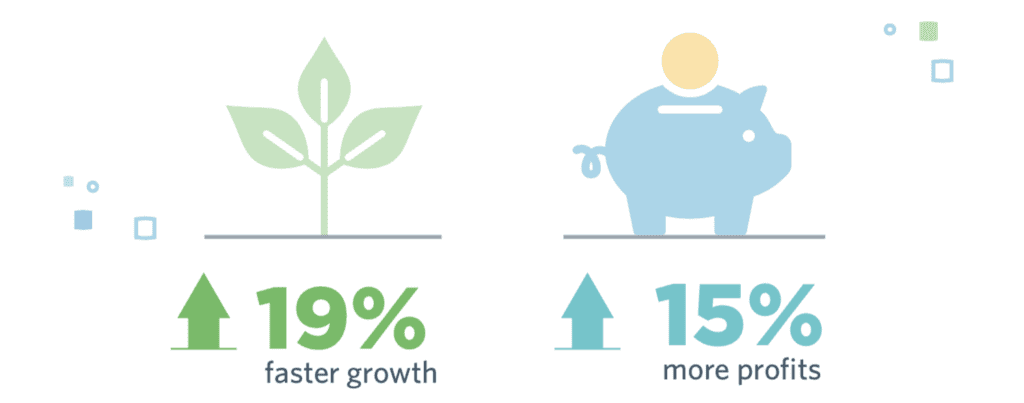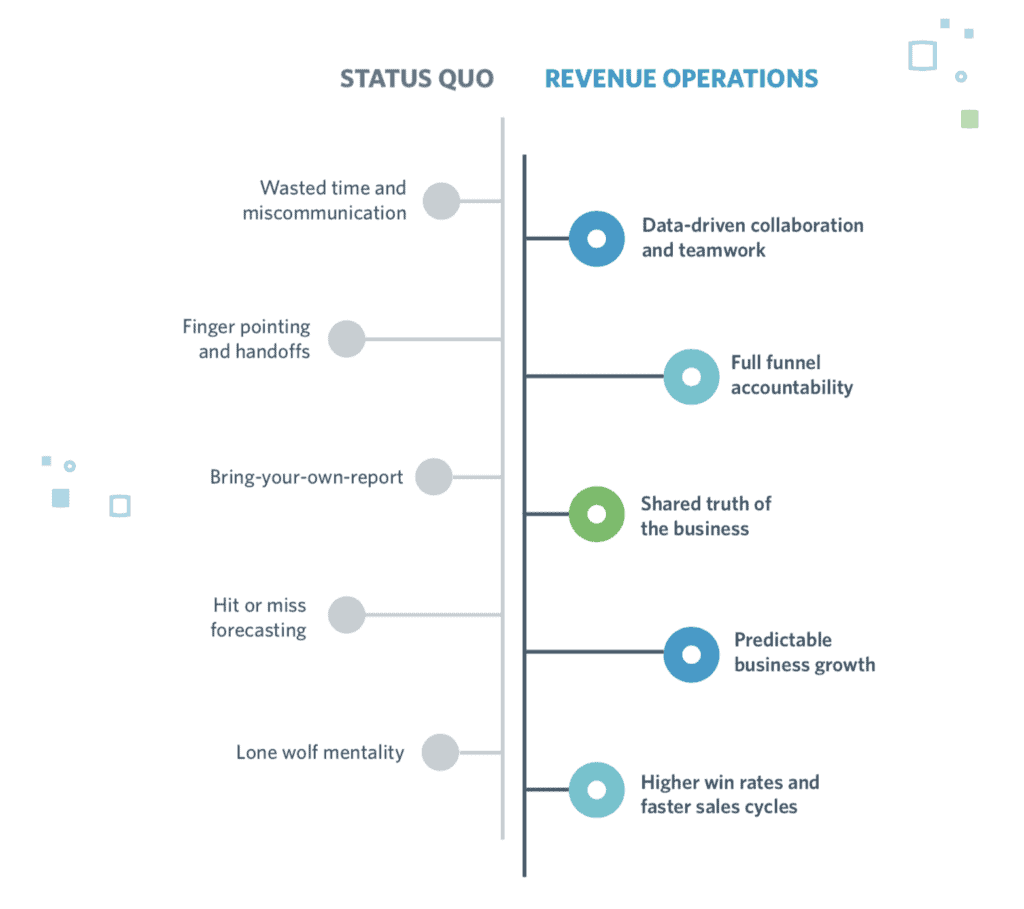If you’re an entrepreneur or work in the tech industry, you know that marketing buzzwords come and go all the time.
And the term “RevOps” certainly sounds buzzy.
You may have seen it mentioned on Twitter or noticed that revenue-focused job listings are skyrocketing. Is it worth paying attention?

Revenue operations (“RevOps”) as a phrase may or may not have long-term staying power. But we still think that missing out on what it signifies — a fundamental shift toward a comprehensive approach to revenue management — is a big mistake.
Why you might ask? It’s simple — the benefits of revenue operations on business performance is undeniable. A recent SirusDecisions study found that public companies with RevOps functions saw a 71% higher stock performance. And, these aligned companies typically see 19% faster growth and 15% more profits compared to their un-aligned public counterparts.

If you’re still new to the concept of RevOps, you’re in the right place. By the end of this article, you’ll have a good idea of what RevOps is and the different ways it can manifest in your business.
You’ll learn how RevOps:
- Aligns revenue-driven values across many departments
- Makes sure your operational infrastructure is as efficient and revenue-focused as possible
- Lays a solid foundation for insights from reporting and analytics
Introducing RevOps
As we mentioned in our post Think Relationships, Not Subscriptions, smart tech leaders have figured out that the work of winning new revenue (marketing and sales) and then retaining that revenue (customer support) should be aligned — not totally siloed into separate departments.
RevOps is the approach that companies are using to unify and streamline those customer-facing, revenue-focused efforts.
But when it comes to making that alignment a reality, things can get a little dicey. True alignment takes more than a few meetings or even a few new hires. It requires changing your company’s values, processes and reporting tools.
The exact definition and execution of RevOps can vary a lot from one company to the next.
But to explain what we think RevOps really means, let’s use a sports analogy. Think of your company as a sports team — one in which the players have to pass a ball back and forth in order to score and win (basketball, soccer, volleyball — pick your favorite).
If customer-facing departments (sales, marketing, customer support) are like the players, RevOps can step into the following roles.
The Coach (The Values and Ethos)
In team sports, each player specializes in a distinct position. And each player has his own unique strengths, specialties, personal goals and playing style.
But it doesn’t matter how well any single athlete plays if the team can’t work together to win games. That’s where a good coach comes in.
Coaches make sure players are working together as a cohesive unit with a shared goal. They give context and urgency to the team’s goals. In addition to helping individual players get better, they build team values and culture. They decide on big-picture strategies.
RevOps can play a similar role in your company.

A RevOps department can serve as a central hub for all things revenue and direct the big-picture strategy for all client-facing departments. And a director of revenue or chief revenue officer can direct the sales, marketing and customer support departments with a laser-focus on revenue growth.
Consistent leadership paves the way for a similar ethos across all customer-facing, revenue-driven departments, which means that customers will get the consistent service that they expect from your brand.
The Team Manager (The Processes and Procedures)
The coach might be the one setting the tone, culture and the goals for the team.
But those values will only come to life with the help of solid execution. Someone needs to take care of the details and invest in infrastructure that enables players to do their jobs properly.
This work often falls to someone in a team management role. A team manager may create schedules, round up supplies, facilitate communication, look over budgets, assign critical admin tasks and make sure each player has the equipment they need.
RevOps departments can play a similar role in tech companies. RevOps staff can take ownership of the procedures and processes that cross over between marketing, sales and customer support.
This might mean diving into jobs such as:
- Creating a customer journey map to make sure everyone is clear about their responsibilities in the customer journey
- Making sure customer handoffs between departments are as smooth as possible
- Searching for inefficiencies and “leaks” in interdepartmental workflows
The Statistician (The Reporting Tools)
The coach and management staff of a sports team shouldn’t make decisions based on gut feelings alone. Their choices should be informed by plenty of hard data.
Think of how a sports statistician collects and analyzes data about player performance, overall team performance and competitors’ performance. These insights help team leaders understand how they stack up against similar teams and what needs to improve.
And, just as a coach wouldn’t look strictly at individual players’ performance statistics, your RevOps staff should be analyzing the entire revenue cycle, not just part of it.

Switching to a RevOps focus means calculating things like the lifetime cost to serve a customer and the lifetime value of the customer, taking into account expenses from each stage (such as sales commissions or pricing promotions). It means trying to get that elusive 360-degree view of customers to understand what attracts them to your company and what makes them stay there.
This is where tools like Maxio are essential. The best billing and subscription management platforms give users more accurate ways to measure sales performance. They have numerous advantages over third-party analytics programs because they process the transactions directly. That means a lot more insights into when, how and why revenue comes in.
Users can organize revenue and growth trends by customer, and even drill down to see individual movements for each subscription.
Software tools like Maxio can also help on the management side, allowing users to create workflows that can better align customer handoffs between departments.
Making RevOps the Head Coach
Most companies recognize the need to measure revenue in a more complete, more helpful way, so they start implementing RevOps on the data end.
This in itself is actually a huge step in the right direction for most companies, and it can be a great place to start.
However, there’s no reason to completely relegate RevOps to the statistician role.
Aligning all revenue-driven operations under similar values and airtight procedures is the best way to lay a foundation for a great customer experience.
Your customer experience might be just fine right now. But as your company grows, processes will change. Don’t wait until inefficiencies and friction start to make a noticeable difference in your bottom line. You should put systems and people in place now to make ensure revenue is always maximized and all revenue-driving functions are working toward the same goal.

Some companies have already restructured to move sales, marketing and support departments under the leadership of a CRO. Others have dedicated RevOps employees who actively work to improve communication and workflows across the entire revenue cycle.
But you don’t need to dismantle existing departments or hire new specialists to refocus your energies on revenue management. In fact, you don’t even have to mention the word “RevOps” to your staff.
Anyone on staff, including the CEO, can wear the hat of revenue director. It simply requires paying attention to the revenue cycle as a whole, and dedicating special attention to driving a consistent customer experience — especially as customers transition between your departments.
Stay tuned. We’ll be discussing more about how to make this revenue-focused shift in your business in upcoming posts.

